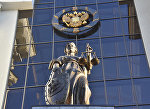MOSCOW, October 22 - RAPSI, Ingrid Burke. The International Cycling Union (UCI) announced Monday its recognition of the United States Anti-Doping Agency’s (USADA) reasoned decision against disgraced former world cycling champion Lance Armstrong, thus upholding the USADA decision to strip Armstrong of all competitive results achieved since August 1998, including seven Tour de France victories.
The UCI didn’t mince words in voicing its disapproval of the decision’s findings, stating in reference to the testimonies of former teammates that comprised much of the USADA’s body of evidence against Armstrong, “Their accounts of their past provide a shocking insight into the USPS Team where the expression to ‘win at all costs’ was redefined in terms of deceit, intimidation, coercion and evasion.”
After the USADA’s initial announcement of the sanctions in late August, the UCI remained tight-lipped about its recognition of the decision, thus leaving its recognition of the latter’s decision hanging in the balance. Shortly after the USADA sanctions were made public, the UCI pointed out that: “Article 8.3 of the World Anti-Doping Code (WADC) states that where no hearing occurs the Anti-Doping Organisation with results management responsibility shall submit to the parties concerned (Mr Armstrong, WADA and UCI) a reasoned decision explaining the action taken.”
In late September, more than a month later, the UCI broke its silence for purposes of publicly chiding the USADA on account of its failure to produce the anticipated decision in a timely fashion. UCI President Pat McQuaid charged, “The UCI had no reason to assume that a full case file did not exist but USADA’s continued failure to produce the decision is now a cause for concern… It is over a month since USADA sanctioned Lance Armstrong. We thought that USADA were better prepared before initiating these proceedings.” Noting the USADA’s excuse that it was still gathering evidence against Armstrong at the time, the UCI pondered, “It is at very least unusual that USADA would still be gathering evidence against a person after it has found that person guilty.”
The USADA finally delivered its reasoned response earlier this month in the form of a scathing 200+ page indictment painting Armstrong as something of a monster. The report, replete with allegations of drug trafficking, lies, threats, witness intimidation, and Swiss bank accounts, centers primarily on the allegation that Armstrong’s lust for victory could only be satiated by the creation of an illicit drug ring in the form of a pro-cycling team.
The UCI’s present decision comes less than two weeks after the USADA’s submission.
In rendering its decision, the UCI considered jurisdictional issues posed by the case, the statute of limitations on the USADA evidence gathered against Armstrong, and the sanctions imposed against him as a result.
Although the UCI established that at this stage no jurisdictional issue exists, it urged that the USADA should have considered submitting its evidence to a neutral body or individual for assessment, stating, “This would have avoided both the criticism of witch hunt against [Mr.] Armstrong and the criticism that the UCI had a conflict of interest. Also the on occasion animated or overstated language of the reasoned decision as well as incorrect and incomplete statements made in relation with the UCI reflect USADA’s intense involvement in the prosecution which not always serves the degree of detachment that one may expect from a disciplinary decision.”
In considering the statute of limitations on the USADA’s evidence against Armstrong, the UCI asserted the rule clearly established by the World Anti-Doping Agency (WADA) Code that any action taken against an athlete on the basis of an anti-doping violation must be commenced within eight years of the date of the alleged violation. The UCI notes that this statute of limitations serves to protect the interests of the athlete, not those of anti-doping agencies such as itself. Thus the UCI recognizes that it was Armstrong’s prerogative to raise an objection on statute of limitations grounds, and he failed to do so. Still, the UCI urges the importance of WADA’s role in ensuring compliance with the Code. Toward that end, UCI notes that WADA can appeal to the Court of Arbitration for Sport (CAS) “in order to warrant, as is the mission of WADA, that the Code is applied in a uniform way worldwide and that all athletes are treated equally.”
With regard to the veracity of the USADA’s evidence against Armstrong, UCI notes that the statements were made under penalty of perjury. While the UCI acknowledges witness testimonies comprising much of the evidence weren’t subject to cross-examination, the UCI points again to Armstrong’s failure defend himself. On this point, the UCI explains, “It is for Armstrong to defend himself against such witness statements that he deems to be incorrect. It is not for the UCI to do so.”
While the UCI concluded with its decision to adopt the USADA’s sanctions against Armstrong, it included the caveats of its objection to the USADA’s failure to respect the WADA statute of limitations, and of the possibility that if Armstrong or WADA were to choose to appeal to the CAS, the sanctions may be overturned in full or in part.
The UCI will consider the consequences that Armstrong’s retroactive disqualification will have on the sport’s rankings during an upcoming meeting.


